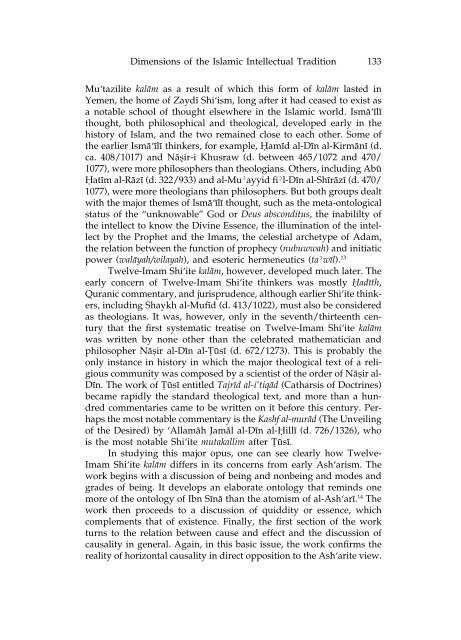Islamic Philosophy from Its Origin to the Present: Philosophy in the ...
Islamic Philosophy from Its Origin to the Present: Philosophy in the ...
Islamic Philosophy from Its Origin to the Present: Philosophy in the ...
You also want an ePaper? Increase the reach of your titles
YUMPU automatically turns print PDFs into web optimized ePapers that Google loves.
Dimensions of <strong>the</strong> <strong>Islamic</strong> Intellectual Tradition 133<br />
Mu‘tazilite kalåm as a result of which this form of kalåm lasted <strong>in</strong><br />
Yemen, <strong>the</strong> home of Zayd¥ Shi‘ism, long after it had ceased <strong>to</strong> exist as<br />
a notable school of thought elsewhere <strong>in</strong> <strong>the</strong> <strong>Islamic</strong> world. Ismå‘¥l¥<br />
thought, both philosophical and <strong>the</strong>ological, developed early <strong>in</strong> <strong>the</strong><br />
his<strong>to</strong>ry of Islam, and <strong>the</strong> two rema<strong>in</strong>ed close <strong>to</strong> each o<strong>the</strong>r. Some of<br />
<strong>the</strong> earlier Ismå‘¥l¥ th<strong>in</strong>kers, for example, ¡am¥d al-D¥n al-Kirmån¥ (d.<br />
ca. 408/1017) and Nå∑ir-i Khusraw (d. between 465/1072 and 470/<br />
1077), were more philosophers than <strong>the</strong>ologians. O<strong>the</strong>rs, <strong>in</strong>clud<strong>in</strong>g Ab¨<br />
¡at¥m al-Råz¥ (d. 322/933) and al-Mu˘ayyid fi˘l-D¥n al-Sh¥råz¥ (d. 470/<br />
1077), were more <strong>the</strong>ologians than philosophers. But both groups dealt<br />
with <strong>the</strong> major <strong>the</strong>mes of Ismå‘¥l¥ thought, such as <strong>the</strong> meta-on<strong>to</strong>logical<br />
status of <strong>the</strong> “unknowable” God or Deus absconditus, <strong>the</strong> <strong>in</strong>abililty of<br />
<strong>the</strong> <strong>in</strong>tellect <strong>to</strong> know <strong>the</strong> Div<strong>in</strong>e Essence, <strong>the</strong> illum<strong>in</strong>ation of <strong>the</strong> <strong>in</strong>tellect<br />
by <strong>the</strong> Prophet and <strong>the</strong> Imams, <strong>the</strong> celestial archetype of Adam,<br />
<strong>the</strong> relation between <strong>the</strong> function of prophecy (nubuwwah) and <strong>in</strong>itiatic<br />
power (walåyah/wilayah), and esoteric hermeneutics (ta˘w¥l). 13<br />
Twelve-Imam Shi‘ite kalåm, however, developed much later. The<br />
early concern of Twelve-Imam Shi‘ite th<strong>in</strong>kers was mostly ¡ad¥th,<br />
Quranic commentary, and jurisprudence, although earlier Shi‘ite th<strong>in</strong>kers,<br />
<strong>in</strong>clud<strong>in</strong>g Shaykh al-Muf¥d (d. 413/1022), must also be considered<br />
as <strong>the</strong>ologians. It was, however, only <strong>in</strong> <strong>the</strong> seventh/thirteenth century<br />
that <strong>the</strong> first systematic treatise on Twelve-Imam Shi‘ite kalåm<br />
was written by none o<strong>the</strong>r than <strong>the</strong> celebrated ma<strong>the</strong>matician and<br />
philosopher Nå∑ir al-D¥n al-apple¨s¥ (d. 672/1273). This is probably <strong>the</strong><br />
only <strong>in</strong>stance <strong>in</strong> his<strong>to</strong>ry <strong>in</strong> which <strong>the</strong> major <strong>the</strong>ological text of a religious<br />
community was composed by a scientist of <strong>the</strong> order of Nå∑ir al-<br />
D¥n. The work of apple¨s¥ entitled Tajr¥d al-i‘tiqåd (Catharsis of Doctr<strong>in</strong>es)<br />
became rapidly <strong>the</strong> standard <strong>the</strong>ological text, and more than a hundred<br />
commentaries came <strong>to</strong> be written on it before this century. Perhaps<br />
<strong>the</strong> most notable commentary is <strong>the</strong> Kashf al-muråd (The Unveil<strong>in</strong>g<br />
of <strong>the</strong> Desired) by ‘Allamåh Jamål al-D¥n al-¡ill¥ (d. 726/1326), who<br />
is <strong>the</strong> most notable Shi‘ite mutakallim after apple¨s¥.<br />
In study<strong>in</strong>g this major opus, one can see clearly how Twelve-<br />
Imam Shi‘ite kalåm differs <strong>in</strong> its concerns <strong>from</strong> early Ash‘arism. The<br />
work beg<strong>in</strong>s with a discussion of be<strong>in</strong>g and nonbe<strong>in</strong>g and modes and<br />
grades of be<strong>in</strong>g. It develops an elaborate on<strong>to</strong>logy that rem<strong>in</strong>ds one<br />
more of <strong>the</strong> on<strong>to</strong>logy of Ibn S¥nå than <strong>the</strong> a<strong>to</strong>mism of al-Ash‘ar¥. 14 The<br />
work <strong>the</strong>n proceeds <strong>to</strong> a discussion of quiddity or essence, which<br />
complements that of existence. F<strong>in</strong>ally, <strong>the</strong> first section of <strong>the</strong> work<br />
turns <strong>to</strong> <strong>the</strong> relation between cause and effect and <strong>the</strong> discussion of<br />
causality <strong>in</strong> general. Aga<strong>in</strong>, <strong>in</strong> this basic issue, <strong>the</strong> work confirms <strong>the</strong><br />
reality of horizontal causality <strong>in</strong> direct opposition <strong>to</strong> <strong>the</strong> Ash‘arite view.

















